1993 CADILLAC ELDORADO tire type
[x] Cancel search: tire typePage 201 of 398
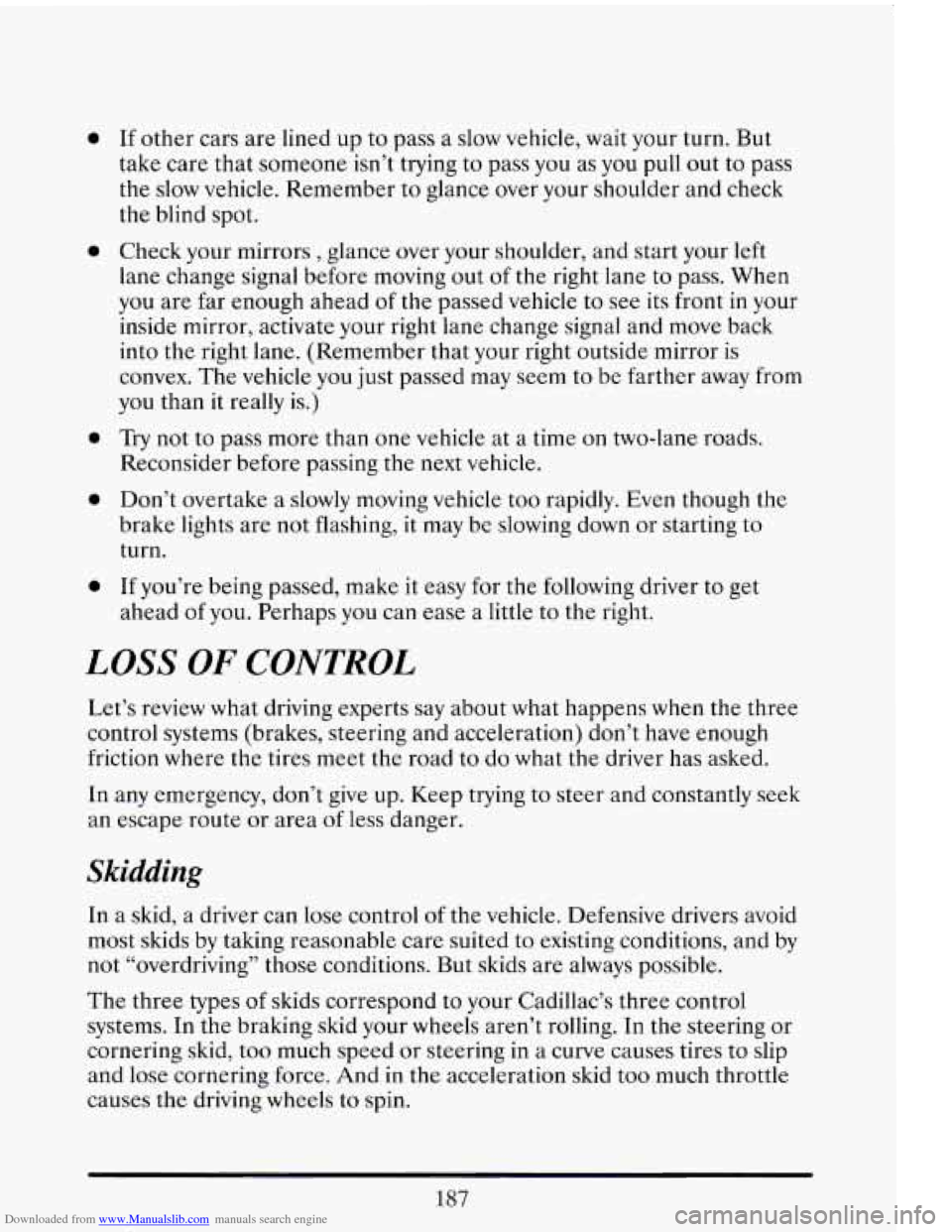
Downloaded from www.Manualslib.com manuals search engine 0
a
0
a
0
If other cars are lined up to pass a slow vehicle, wait your turn. But
take care that someone isn’t trying to pass you as you pull out to pass
the slow vehicle. Remember to glance over your shoulder and check
the blind spot.
Check your mirrors
, glance over your shoulder, and start your left
lane change signal before moving out
of the right lane to pass. When
you are far enough ahead
of the passed vehicle to see its front in your
inside mirror, activate your right lane change signal and move back
into the right lane. (Remember that your right outside mirror is
convex. The vehicle
you just passed may seem to be farther away from
you than it really is.)
Try not to pass more than one vehicle at a time on two-lane roads.
Reconsider before passing the
next vehicle.
Don’t overtake
a slowly moving vehicle too rapidly. Even though the
brake lights are not flashing, it may be slowing down or starting to
turn.
If you’re being passed, make it easy for the following driver to get
ahead of you. Perhaps you can ease a little to the right.
LOSS OF CONTROL
Let’s review what driving experts say about what happens when the three
control systems (brakes, steering and acceleration) don’t have enough
friction where the tires meet the road to do what
the driver has asked.
In any emergency, don’t give up. Keep trying to steer and constantly seek
an escape route or area
of less danger.
Skidding
In a skid, a driver can lose control of the vehicle. Defensive drivers avoid
most skids by taking reasonable care suited to existing conditions, and
by
not “overdriving” those conditions. But skids are always possible.
The three types
of skids correspond to your Cadillac’s three control
systems. In the braking skid your wheels aren’t rolling. In the steering or
cornering skid, too much speed
or steering in a curve causes tires to slip
and
lose cornering force. And in the acceleration skid too much throttle
causes the driving wheels to spin.
Page 227 of 398
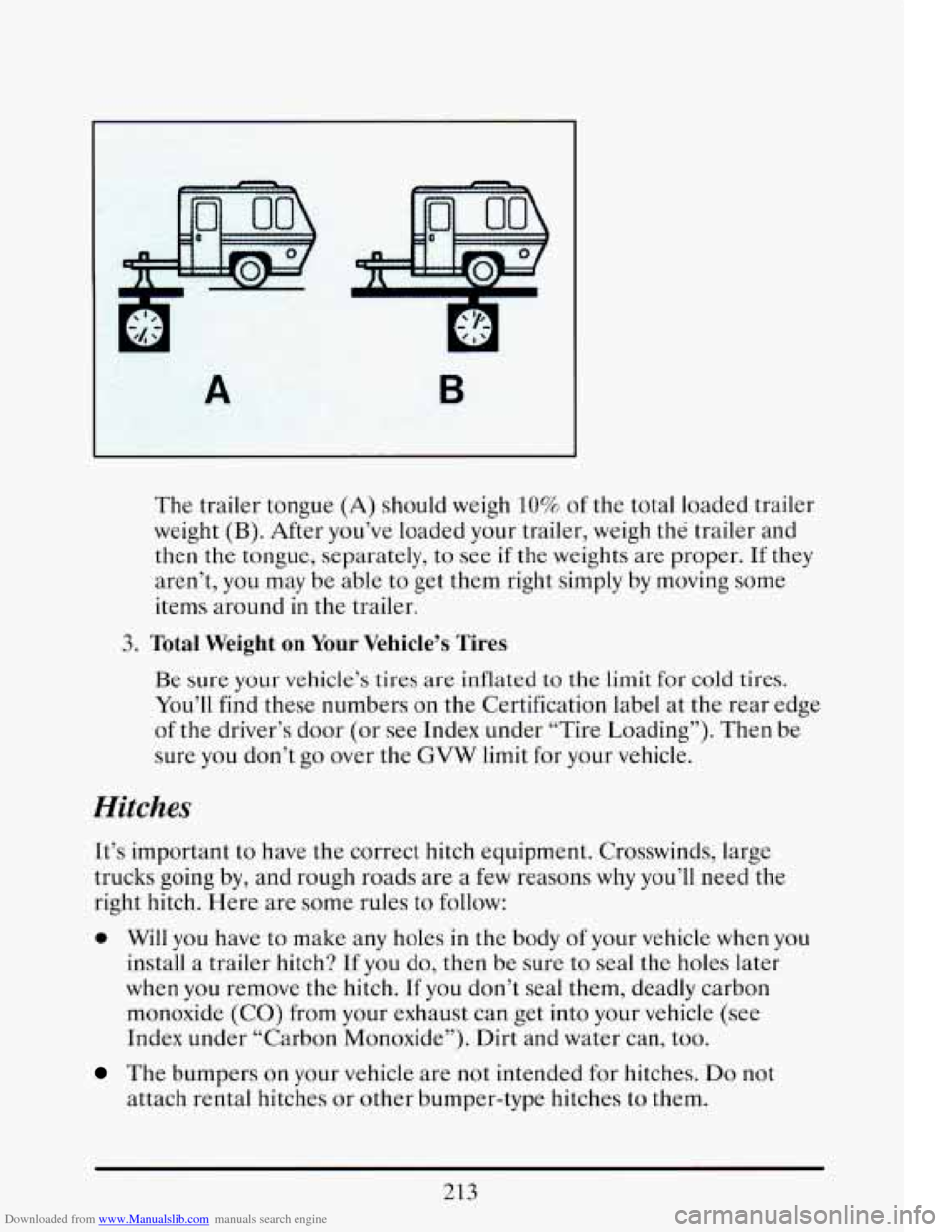
Downloaded from www.Manualslib.com manuals search engine The trailer tongue (A) should weigh 10% of the total loaded trailer
weight
(B). After you’ve loaded your trailer, weigh the trailer and
then the tongue, separately, to see
if the weights are proper. If they
aren’t, you may be able to get them right simply
by moving some
items around in the trailer.
3. Total Weight on Your Vehicle’s Tires
Be sure your vehicle’s tires are inflated to the limit for cold tires.
You’ll find these numbers on the Certification label at the rear edge\
of the driver’s door (or see Index under “Tire Loading”). Then be
sure you don’t go over the
GVW limit for your vehicle.
Hitches
It’s important to have the correct hitch equipment. Crosswinds, large
trucks going by, and rough roads are a
few reasons why you’ll need the
right hitch. Here are some rules to follow:
0 Will you have to make any holes in the body of your vehicle when you
install a trailer hitch? If you do, then be sure to seal the holes later
when
you remove the hitch. If you don’t seal them, deadly carbon
monoxide
(CO) from your exhaust can get into your vehicle (see
Index under “Carbon Monoxide”). Dirt and water can, too.
The bumpers on your vehicle are not intended for hitches. Do not
attach rental hitches or other bumper-type hitches to them.
213
Page 242 of 398
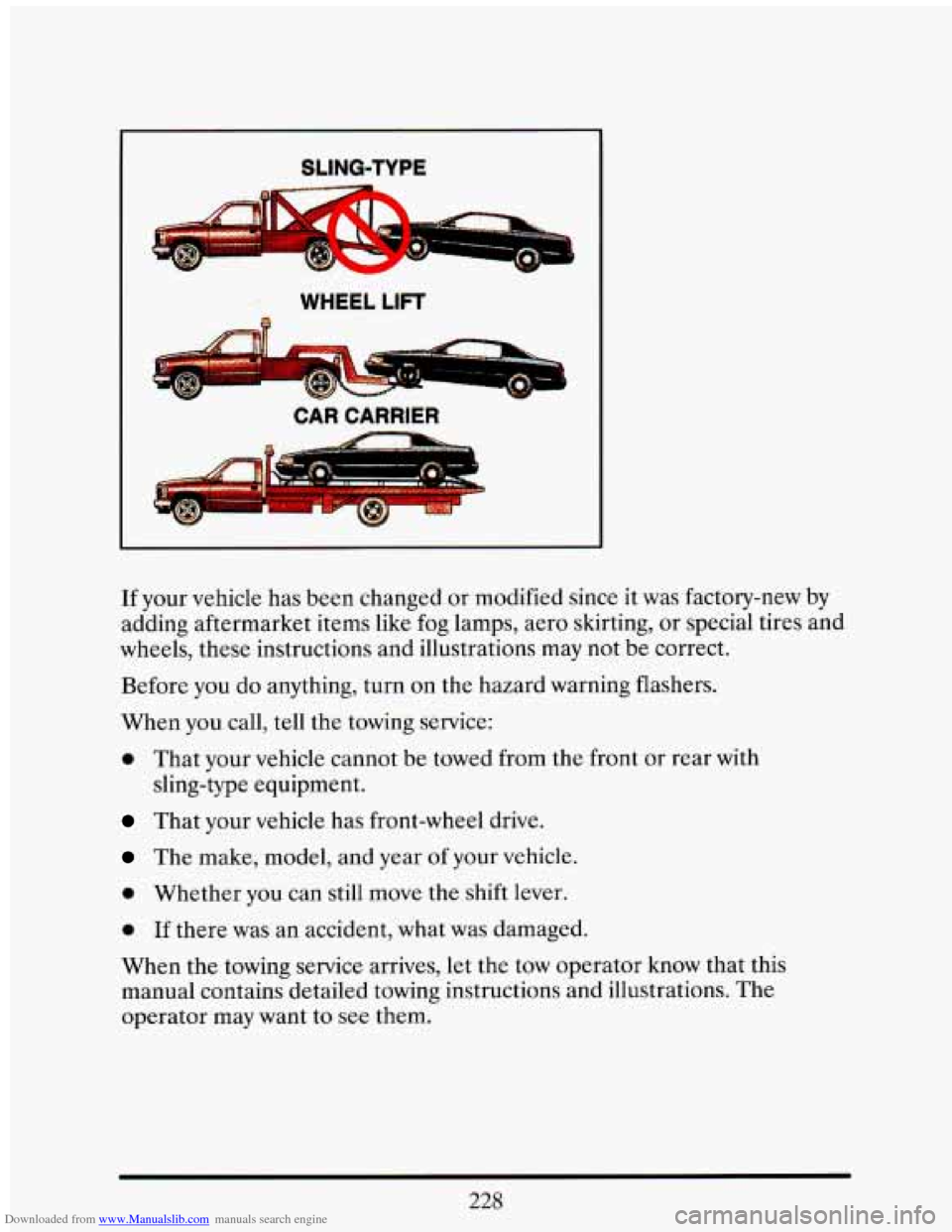
Downloaded from www.Manualslib.com manuals search engine I SLING-TYPE
WHEEL LIFT
If your vehicle has been changed or modified since it was factory-new by
adding aftermarket items like fog lamps, aero skirting, or spec\
ial tires and
wheels, these instructions and illustrations may not be correct.
Before
you do anything, turn on the hazard warning flashers.
When
you call, tell the towing service:
0 That your vehicle cannot be towed from the front or rear with
That your vehicle has front-wheel drive.
The make, model, and year of your vehicle.
0 Whether you can still move the shift lever.
sling-type equipment,
0 If there
was an accident, what was damaged.
When the towing service arrives, let the
tow operator know that this
manual contains detailed towing instructions and illustrations. The
operator may want
to see them.
228
Page 324 of 398

Downloaded from www.Manualslib.com manuals search engine Buying New Tires
To find out what kind and size of tires you need, look at the Tire-Loading
Information label.
The tires installed on your vehicle when it was new had a Tire
Performance Criteria Specification (TPC Spec) number on each tire’s
sidewall. When you
get new tires, get ones with that same TPC Spec
number. That way, your vehicle will continue to have tires that are
designed to give proper endurance, handling, speed rating, traction, ride
and other things during normal service on your vehicle. If your tires have
an all-season tread design, the TPC number will be followed by a
“MS”
(for mud and snow).
If you ever replace your tires with those not having a TPC Spec number,
make sure they are the same size, load range, speed rating and
construction type (bias, bias-belted or radial) as your original tires.
A CAUTION:
Mixing tires could cause you to lose control while driving. If you
mix tires of different sizes or types (radial and bias-belted
tires), the vehicle may not handle properly, and you could have
a
crash. Be sure to use the same size and type tires on all four
wheels.
It’s all right to drive with your compact spare, though. It was
developed
for use on your vehicle.
Uniform Tire Quality Grading
The following information relates to the system developed by the United
States National Highway Traffic Safety Administration which grades tires
by treadwear, traction and temperature performance. (This applies only
to vehicles sold in the United States.)
Page 326 of 398
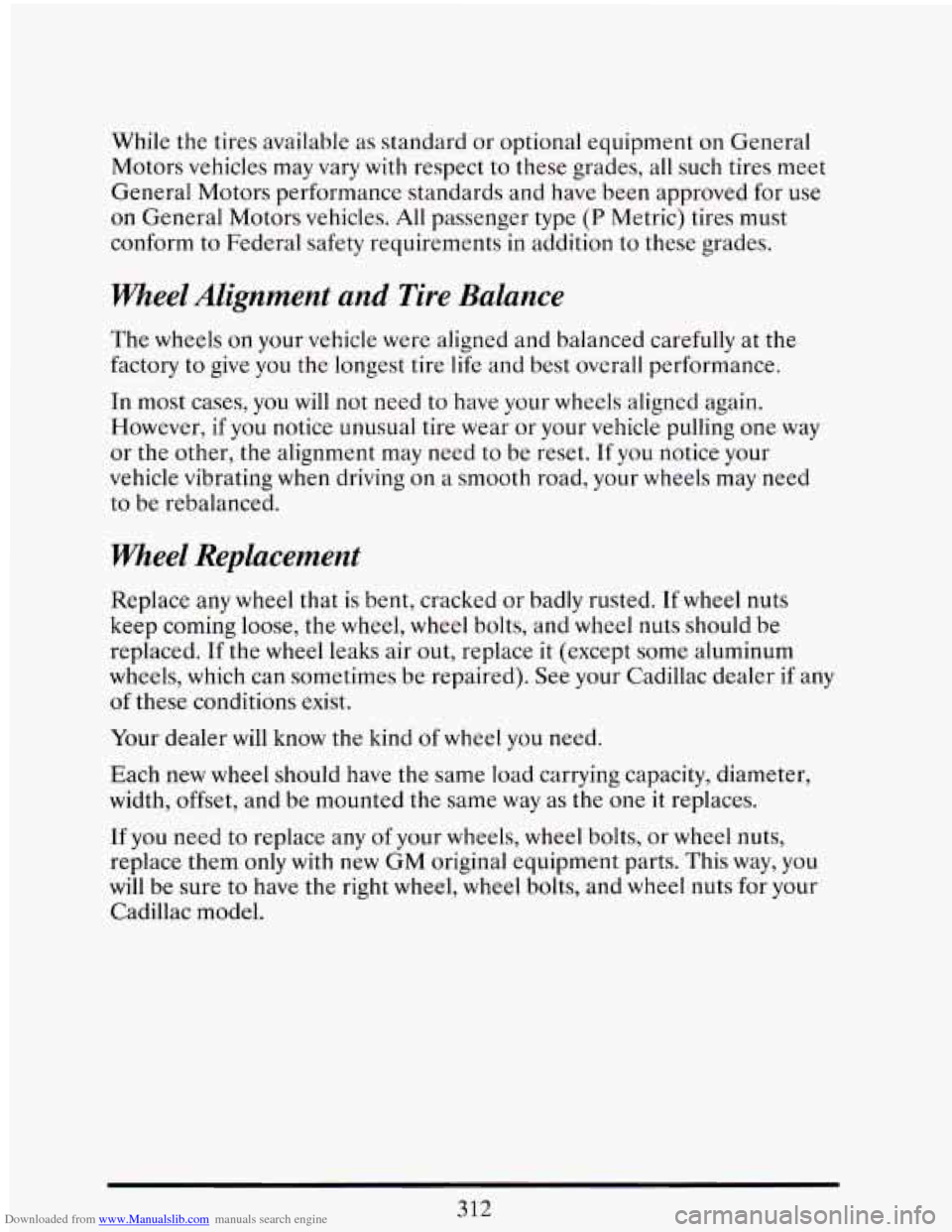
Downloaded from www.Manualslib.com manuals search engine While the tires available as standard or optional equipment on General
Motors vehicles may vary
with respect to these grades, all such tires meet
General Motors performance standards and have been approved for use
on General Motors vehicles. All passenger type
(P Metric) tires must
conform to Federal safety requirements in addition
to these grades.
meel Alignment and Tire Balance
The wheels on your vehicle were aligned and balanced carefully at the
factory to give
you the longest tire life and best overall performance.
In most cases, you will not need to have your wheels aligned again.
However,
if you notice unusual tire wear or your vehicle pulling one way
or the other,
the alignment may need to be reset. If you notice your
vehicle vibrating
when driving on a smooth road, your wheels may need
to be rebalanced.
Wheel Replacement
Replace any wheel that is bent, cracked or badly rusted. If wheel nuts
keep coming loose, the wheel, wheel bolts, and wheel nuts should be
replaced. If the
wheel leaks air out, replace it (except some aluminum
wheels, which can sometimes be repaired). See your Cadillac dealer if any
of these conditions exist.
Your dealer
will know the kind of wheel you need.
Each new
wheel should have the same load carrying capacity, diameter,
width, offset, and be mounted the same way as the one
it replaces.
If you need to replace any of your wheels, wheel bolts, or wheel nuts,
replace them only
with new GM original equipment parts. This way, you
will be sure to have the right wheel, wheel bolts, and wheel nuts for your
Cadillac model.
312
Page 330 of 398
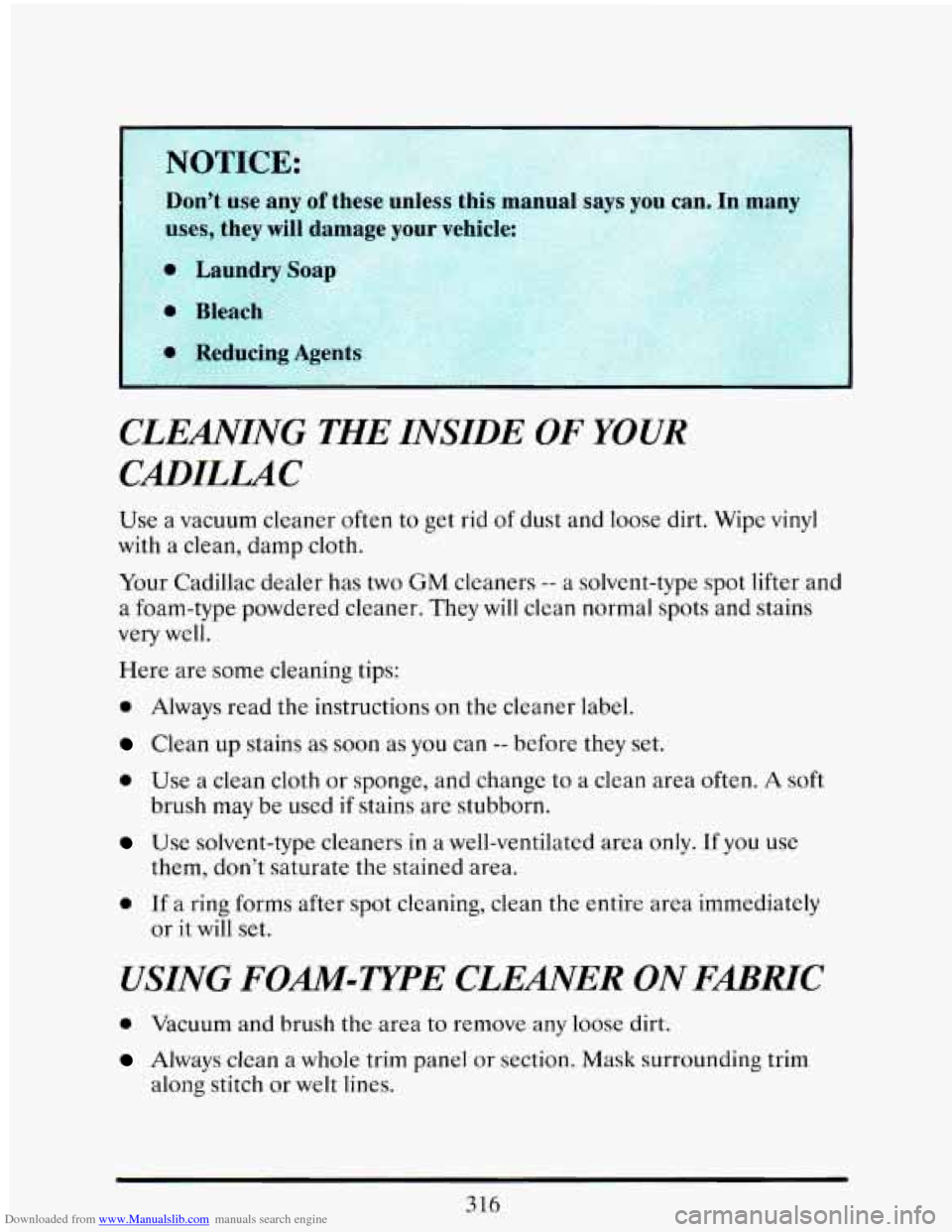
Downloaded from www.Manualslib.com manuals search engine L
CLEANING THE INSIDE OF YOUR
Use a vacuum cleaner often to get rid of dust and loose dirt. wipe vinyl
with a
clean, damp cloth.
Your Cadillac dealer
has two GM cleaners -- a solvent-type spot lifter and
a foam-type powdered cleaner. They will clean normal spots and stains
very well.
Here are some cleaning tips:
0 Always read the instructions on the cleaner label.
Clean up stains as soon as you can -- before they set.
0 Use a clean cloth or sponge, and change to a clean area often. A soft
Use solvent-type cleaners in a well-ventilated area only. If you use
0 If a ring forms after spot cleaning, clean the entire area immediately
brush
may
be used if stains are stubborn.
them, don’t saturate the stained area.
or
it will set.
USING FON=WPE CLEANER ON FMRIC
0 Vacuum and brush the area to remove any loose dirt.
Always clean a whole trim panel or section. Mask surrounding trim
along stitch or welt lines.
316
Page 338 of 398
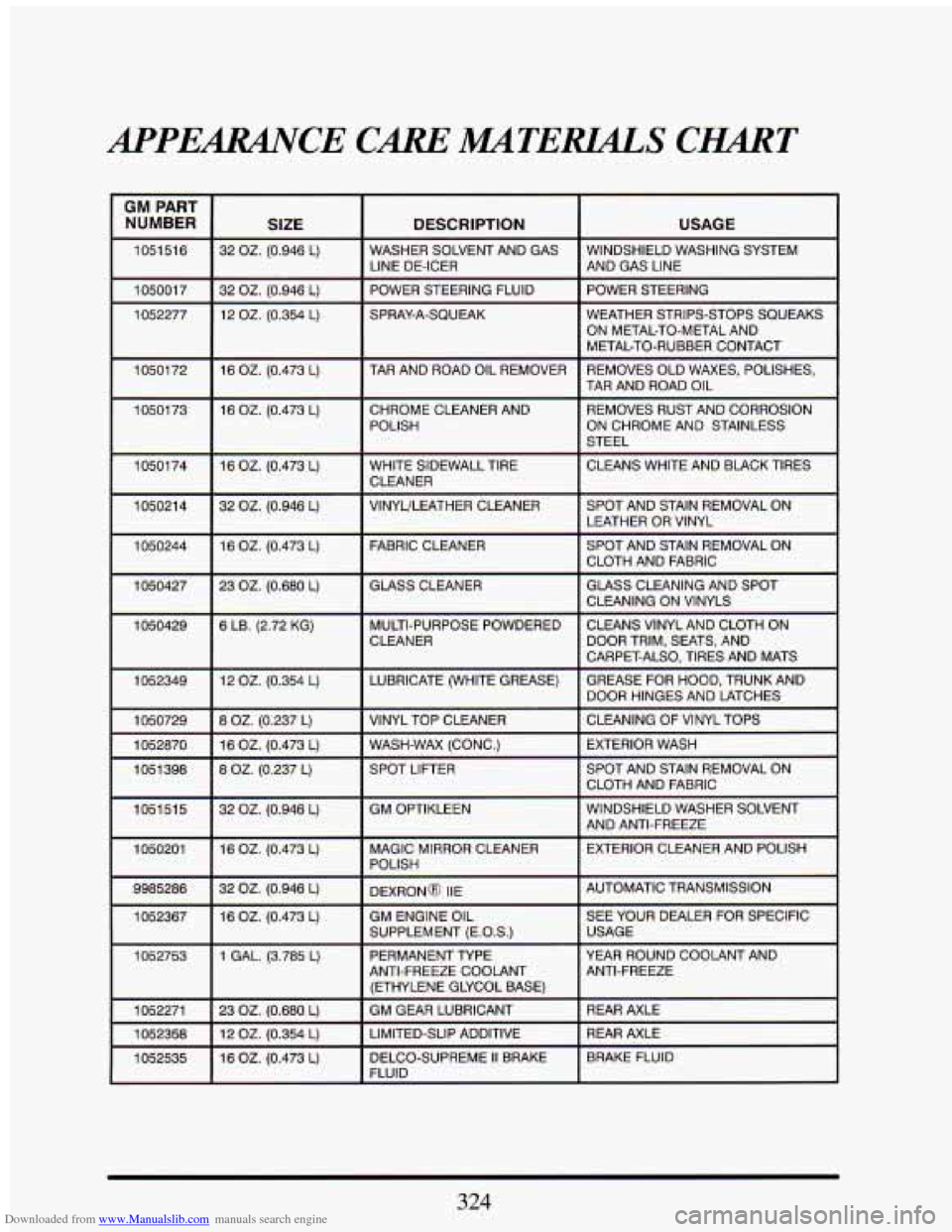
Downloaded from www.Manualslib.com manuals search engine GM PART
NUMBER
SIZE I DESCRIPTION USAGE
1051516 WINDSHIELD WASHING SYSTEM
AND GAS LINE 32 OZ. (0.946 L) WASHER SOLVENT AND GAS
105001 7 POWER STEERING
WEATHER STRIPS-STOPS SQUEAKS ON METAL-TO-METAL AND
METAL-TO-RUBBER CONTACT
1052277
I 1050172 I
16 OZ. (0.473 L) I TAR AND ROAD OIL REMOVER
I
REMOVES OLD WAXES, POLISHES,
TAR AND ROAD OIL
I
CHROME CLEANER AND
POLISH ' REMOVES RUST AND CORROSION
ON CHROME AND STAINLESS
STEEL
CLEANS WHITE AND BLACK TIRES
WHITE SIDEWALL TIRE
SPOT AND STAIN REMOVAL ON
LEATHER
OR VINYL
SPOT AND STAIN REMOVAL ON
CLOTH AND FABRIC
I 1050427 I I GLASS CLEANER I 23 OZ. (0.680 L) GLASS CLEANING AND SPOT
CLEANING ON VINYLS
I
1050429 6 LB. (2.72 KG)
I
MULTI-PURPOSE POWDERED
CLEANER CLEANS VINYL AND CLOTH
ON
DOOR TRIM, SEATS, AND
CARPET-ALSO. TIRES AND MATS
1052349 12 Of. (0.354 L) LUBRICATE (WHITE GREASE)
1050729 8 OZ. (0.237 L) VINYL TOP CLEANER
1052870
16 OZ. (0.473 L)
WASH-WAX (CONC.) GREASE FOR HOOD, TRUNK
AND
DOOR HINGES AND LATCHES
CLEANING
OF VINYL TOPS
EXTERIOR WASH
SPOT AND STAIN REMOVAL ON
CLOTH AND FABRIC
WINDSHIELD WASHER SOLVENT AND ANTI-FREEZE
1051 398 8 OZ. (0.237 L) SPOT LIFTER
1051515 32 OZ. (0.946 L) GM OPTIKLEEN
EXTERIOR CLEANER AND POLISH
16 OZ. (0.473 L) MAGIC MIRROR CLEANER
POLISH
32 OZ. (0.946 L) DEXRONQ IIE I 9985286 AUTOMATIC TRANSMISSION
SEE YOUR DEALER
FOR SPECIFIC
USAGE 1 1052367 I SUPPLEMENT (E.0.S.I I 16 OZ. (0.473 L) GM
ENGINE OIL I
YEAR ROUND COOLANT AND
ANTI-FREEZE 1 GAL. (3.785 L) PERMANENT TYPE
ANTI-FREEZE COOLANT
16 OZ. (0.473 L) DELCO-SUPREME II BRAKE
1052753
REAR AXLE
REAR AXLE
BRAKE FLUID
I I I FLUID 1
324
Page 386 of 398
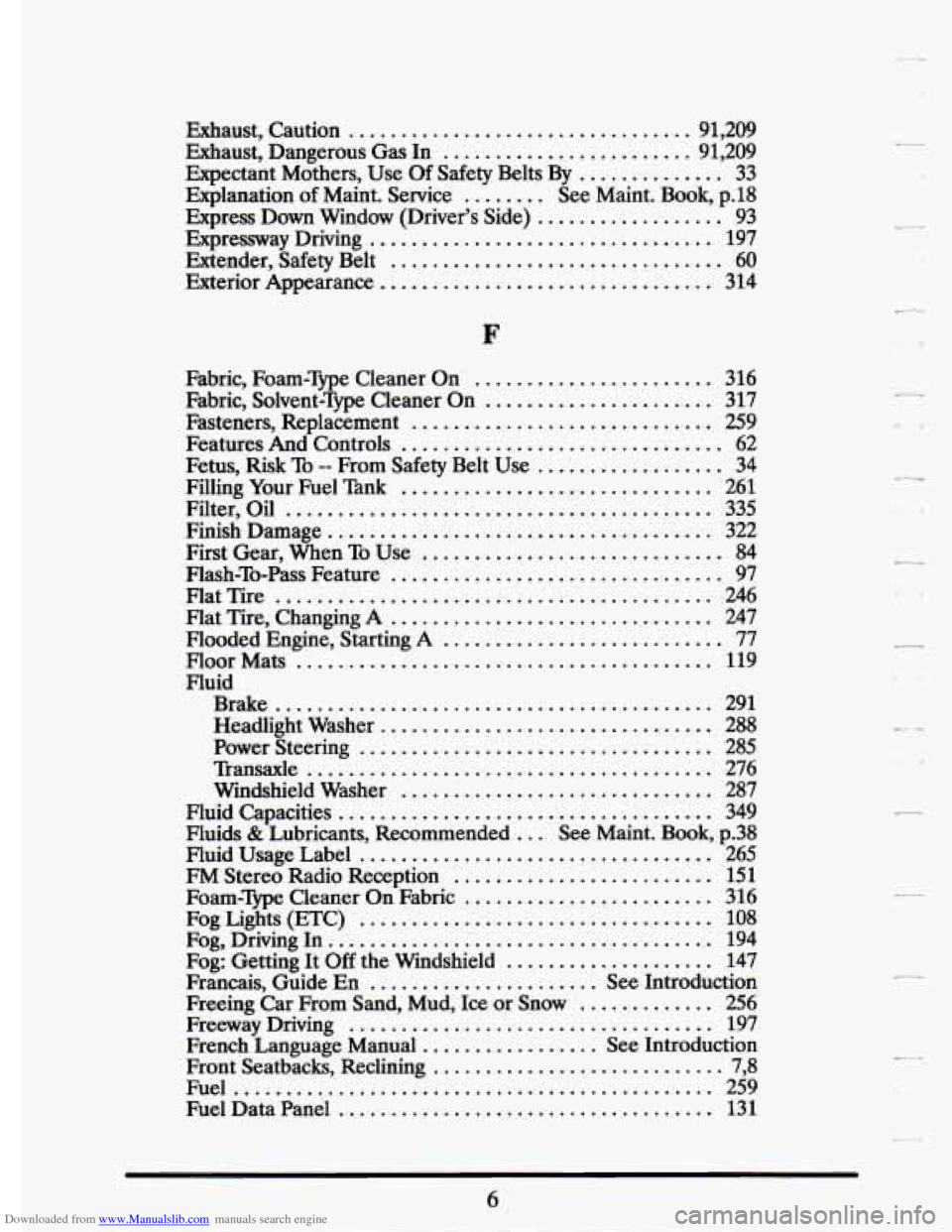
Downloaded from www.Manualslib.com manuals search engine Exhaust. Caution ................................. 91. 209
Exhaust. Dangerous Gas In ........................ 91. 209
Expectant Mothers. Use Of Safety Belts By .............. 33
Explanation of Maint . Service ........ See Maint . Book. p.18
Express Down Window (Driver’s Side) .................. 93
Expressway Driving ................................. 197
Extender. Safety Belt ................................ 60
Exterior Appearance ................................ 314
Fabric. Foam-Type Cleaner On ....................... 316
Fabric. Solvent-Type Cleaner On ...................... 317
Features And Controls ............................... 62
Filling Your Fuel Tank .............................. 261
Filter. Oil ......................................... 335
Finish Damage ..................................... 322
First Gear. When To Use ............................. 84
Flash-To-Pass Feature ................................ 97
Flat Tire .......................................... 246
Flat Tire. Changing A ............................... 247
FloorMats ........................................ 119
Fluid
Brake
.......................................... 291
Headlight Washer ................................ 288
Power Steering .................................. 285
Transaxle ....................................... 276
Windshield Washer .............................. 287
Fluid Capacities .................................... 349
Fluids & Lubricants. Recommended ... See Maint . Book. p.38
Fluid Usage Label .................................. 265
FM Stereo Radio Reception ......................... 151
Foam-Type Cleaner On Fabric ........................ 316
Fog Lights (ETC) .................................. 108
Fog. Driving In ..................................... 194
Francais. Guide En ...................... See Introduction
Freeway Driving
................................... 197
French Language Manual ................. See Introduction
Front Seatbacks. Reclining
............................ 798
Fuel .............................................. 259
FuelDataPanel .................................... 131
Fasteners. Replacement ............................. 259
Fetus. Risk To .. From Safety Belt Use .................. 34
Flooded Engine. Starting A ........................... 77
Fog: Getting It Off the Windshield .................... 147
Freeing Car From Sand. Mud. Ice or Snow ............. 256
.
.
1.
rz
.*
I..
.
. r
7-
.
.
.